Chmod Numbers
Set-group-ID (S_ISGID) with the setgid option.

Chmod numbers. Fun with Numbers in chmod. To view these online, enter. Chmod 4555 equates to the following:.
The sums of these numbers give combinations of these permissions:. Chmod +rwx “filename” chmod-rwx “directory name” Changing permissions for the group owner and other members. Setting Special Permissions With Number Notation.
Chmod +x filename.sh to make filename.sh executable. You may remember from the definitions above that permissions can be set with a series of three numbers. Typical Chmod Permissions Values 644 or -rw-r--r-- web pages and images viewed by surfers.666 or -rw-rw-rw- - log files or pages to which are written.755 or -rwxr-xr-x - perl scripts to make them executable.
(101) Read and execute permissions. (011) Write and execute permissions. Chmod 1755 participants With a sticky bit, only the file owner, the directory owner, or the root superuser can delete the file, regardless of the file's read-and-write group permissions.
Using letters is easier to understand for most people. - rwx r-x r-- info.sh. Set-user-ID (S_ISUID) with the setuid option.
Special, User/Owner, Group, and Others in that order, when working with the four-number chmods, with that first number being special bits that can be set. I’ll also explain some the popular terms like chmod 777 or chmod 755 or chmod -r. Chmod changes the permissions of each given file according to mode, which can be either an octal number representing the bit pattern for the new permissions or a symbolic representation of changes to make, (+-= rwxXstugoa).
Chmod ugo+rwx or chmod u-rw or chmod u=rwx,g=rwx,o=rwx or a=rwx (a means all) At the risk of scaring with a short shell script, it is possible to view all the permissions minus the sticky bit, the SetGUID bit, and the SetUID bit using some loops:. Using symbolic modes (letters to indicate the categories and permission) Using numeric modes (An octal (base 8) number that represents the mode). Mode can be specified with octal numbers or with letters.
Owner can read, write and execute;. Each digit is a combination of the numbers 4, 2, 1, and 0:. It may seem a little complex at first - especially if math isn't your strong suit.
Using chmod with Absolute Permissions. There are 3 types of access level permission which unix gives. Use comma to separate the multiple permission sets as shown below.
In the terminal, the command to use to change file permission is chmod. While 4 is for read, the other two are for write and execute, respectively. We will explain the modes in more detail later in this article.
You can either use numeric (Number based) or symbolic (Letter based) notation to define your permissions with this command. The chmod command with the -R options allows you to recursively change the file’s permissions. The basic format for chmod is chmod xyz file.foo.
A superuser or the file owner can use a chmod command or chmod() function to change two options for an executable file. The three digits of the chmod code set permissions for these groups in this order:. You really only need to memorize 1, 2 and 4 (if there were more options would then go to.
Chmod changes the permissions of each given file according to mode, where mode describes the permissions to modify. The third chmod number is the other’s permission. Change permission for all roles on a file/directory.
For example, Read + Write + Execute permission for Owner, and Read permission for Group and Other, would be Chmod 744. Under each letter, write a digit 1;. Group can read, write and execute;.
Umask is a 3 digit octal number. $ chmod u+x filename 2. Set the permissions for a file or directory by using the chmod command.
Remove permission from a file/directory. If you have any questions or feedback, feel free to leave a comment. It turns out that you can also set the mode numerically.
Chmod Calculator Chmod Calculator is a free utility to calculate the numeric (octal) or symbolic value for a set of file or folder permissions in Linux servers. This is how I remember permissions and most likely, it will help you remember it as well. 4 stands for "read", 2 stands for "write", 1 stands for "execute", and.
Each number represents the permissions of a group - x is for the user that owns the file, y is for the group that owns the file (normally the user's group), and z is for everybody else. From one to four octal digits Any omitted digits are assumed to be leading zeros. Chmod permission number explained.
For example, consider the following example:. The chmod command allows you to change the permissions on a file using either a symbolic or numeric mode or a reference file. By David · September 18, 12.
For example, for Read and Write permissions, you Chmod 6, since Read (4) + Write (2) = 6. Number 1 means that you grant execute rights, number 2 means that you make the file writeable, number 4 means that you make the file readable. It may be used to add or remove permissions symbolically.
6 = rw-7 = rwx For example:. Following example removes read and write permission for the user. The second way to modify permissions with the chmod command is to use a number to specify each set of permissions for the file.
To recursively set permissions of files based on their type, use chmod in combination with the find command. Others can read, write and execute;. 4, 2, and 1.
If this is your first visit, be sure to check out the FAQ by clicking the link above. There are two ways to represent the MODE:. (O)thers can't read, can't write and can't execute.
Group permissio view the full answer. Each remain digit set permission for the owner, group, and world as follows:. Under each dash write a digit zero.
The chmod command in Linux/Unix is abbreviated as CHange MODe. Moving on further, there's also a numerical notation (also known as octal representation) using which you can tell chmod to change permissions. For example, let’ssay you want file info.shto have these permissions.
I think that is it, there might be some other options as well, consult the man page. Let's go back to the original permissions for sneakers.txt. Each permission is assigned a value, as the following table shows, and the total of each set of permissions provides a number for that set.
To make yourlife easier, write the permissions grouped into sets of three letters. You may have to register before you can post:. To start viewing messages, select the forum that you want to visit from the selection below.
The chmod command is used to change the various permission bits of a file or directory. 777) or symbolic notation (e.g. What is CHMOD and what do the numbers mean?.
For example, to set the sticky bit, prefix a 1 to the number sequence:. The first number on the left side is for "user", the middle one is for "group" and the right hand one for "other." Now, here's what each number does:. Rwxrwxrwx) to see its value in other formats.
CHMOD Permissions Reference Chart. 2 = -w-3 = -wx;. 777 or -rwxrwxrwx - directories that have files created inside them.
In short, “chmod 777” means making the file readable, writable and executable by everyone. There's actually 4 attribute sets you can work with via chmod. This is done with the chmod command.
Chmod changes the permissions of each given file according to mode, where mode describes the permissions to modify. In short, “chmod 777” means making the file readable, writable and executable by everyone. 0 stands for "no permission.".
$ chmod u+r,g+x filename 3. There are three numbers you play with in this mode:. The full permissions mode number is a 4-digit octal number, though most of the time, you only use the 3 least-significant digits.
The three rightmost digits define permissions for the file user, the group, and others. The chmod command is used to alter the permissions of a file. File/Directory permission is either Read or Write or executable for either user or group or others.
Sooner or later in the Linux world, you will have to change the permission on a file or directory. (110) Read and write permissions. For example, to add execute.
The digits you can use and what they represent are listed here:. Chmod 770 (chmod a+rwx,o-rwx) sets permissions so that, (U)ser / owner can read, can write and can execute. Bash, Shell, Terminal, Command Line cheat sheets linux Ubuntu.
777 or -rwxrwxrwx - for files that are written to by all. Click the register link above to proceed. $ chmod u-rx filename 4.
User Group Other Read 4 4 4 Write 2 2 2 Execute 1 1 1 U G O X X X Chmods:. This person cannot read, write, or execute the file 1 = execute only. To determine the number you want to set, you can use x=1, w=2, and r=4.
With the chmod command, there are two different notations that you can utilize to specify the permissions that you want to set. The permissions are as follows:. The tool will provide you with an octal code that corresponds to these permissions which can then be applied to relevant directories and files with chmod.
Adding the numbers in each section results in permissions of 664. The command takes the general form:. All possible combinations are represented by a unique number.
An alternative option to specifying the above is to use the 3 digit octal number method (e.g 755), remember the following:. Chmod has two operating modes:. Owner, Group and Other is represented by three numbers.
The second chmod number is the group permission;. Here's another way to change permissions;. Write the permissions you want the file to have.
When chmod is applied to a directory:. In this article, I’ll share with you some of the practical examples of chmod command. 777 = rwxrwxrwx 755 = rwxr-xr-x 644 = rw-r--r-- 700 = rwx----- 750 = rwxr-x---.
Here’s a chmod example using for setting permissions so that:. Add up each group in the permissions string, taking r=4, w=2, x=1. Using the numbering scheme, the chmod command has three number places, for example 744, representing the three user types.
Chmod 700 foldername will give read, write, and execute permissions for the user only.;. 0 = no permissions whatsoever;. Remember when we made a reference to the "shorthand" method of chmod?.
Add up these numbers to specify needed rights. Each row has 2 examples, one for setting that permission for a file, and one for a directory named ‘dir’. This command is similar to the first one, all you need to add in here are “o” for other users and “g” for groups.
The command can accept one or more files and/or directories separated by space as arguments. Chmod 327 foldername will give write and execute (3) permission for the user, w (2) for the group, and read, write, and. Here the digits 7, 5, and 4 each individually represent the permissions for the user, group, and others, in that order.
You would need to do that for each group. You add together the numbers for the permissions you want. To change permission using the Linux chmod command we have to follow some syntax and rules.
The options are set in two file mode bits:. The numbers represent the permissions for owner, group, and world, respectively. The Linux command to change permissions on a file or directory is chmod, which we like to read as change file mode.
Chmod options mode file_name You can change permissions using alphanumeric characters (a+rwx) or with octal numbers (777). 9 Comments Originally posted October 13, 14. Select the permissions you require below.
Man chmod man ls A variable called `umask' is used as a permission mask for all newly created files and directories. Chmod command is useful to change permission for Files and folders in Linux/Unix. The chmod command uses a three-digit code as an argument.
Chmod 777 foldername will give read, write, and execute permissions for everyone.;. 4 = r (Read) 2 = w (Write) 1 = x (eXecute). To get the value for the options determine the type of access needed for the file then add.
The optional leading digit, when 4 digits are given, specifies the special setuid, setgid, and sticky flags. 0 = ---1 = --x;. Here is another way to look at how we come to that number:-(rw-) (rw-) (r--) -(42-) (42-) (4--) 6 6 4.
How to use Check the desired boxes or directly enter a valid numeric value (e.g. (G)roup can read, can write and can execute. So to add read permissiones for people in the files group I would do chmod g+r file.
755 or -rwxr-xr-x - directories are usually given this value. Set UID bit - Run the file as the owner regardless of which user is running it. The chmod numerical format accepts up to four octal digits.
4 = r-5 = r-x;. Add multiple permission to a file/directory. Chmod command is used to set file permission in linux/unix system.
You can also read more about modes on Unix systems with 'man 1 chmod' and 'man 2 chmod'. For more information, including octal specification of permissions, refer to the Unix User's Manual pages for chmod(1) and ls(1). X, y, and z are each a number between 0 and 7.
This type of restriction is useful for effective file/folder management, securing system and providing a level …. Chmod OPTIONS PERMISSIONS FILE. Mode can be specified with octal numbers or with letters.
Definition #--owner -#-group --# other :.

Linux Permissions Guide Plex Support
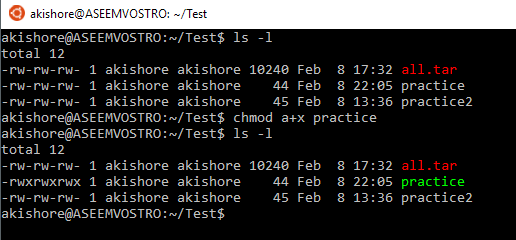
Understanding Linux Permissions And Chmod Usage

Ownership And Permissions
Chmod Numbers のギャラリー
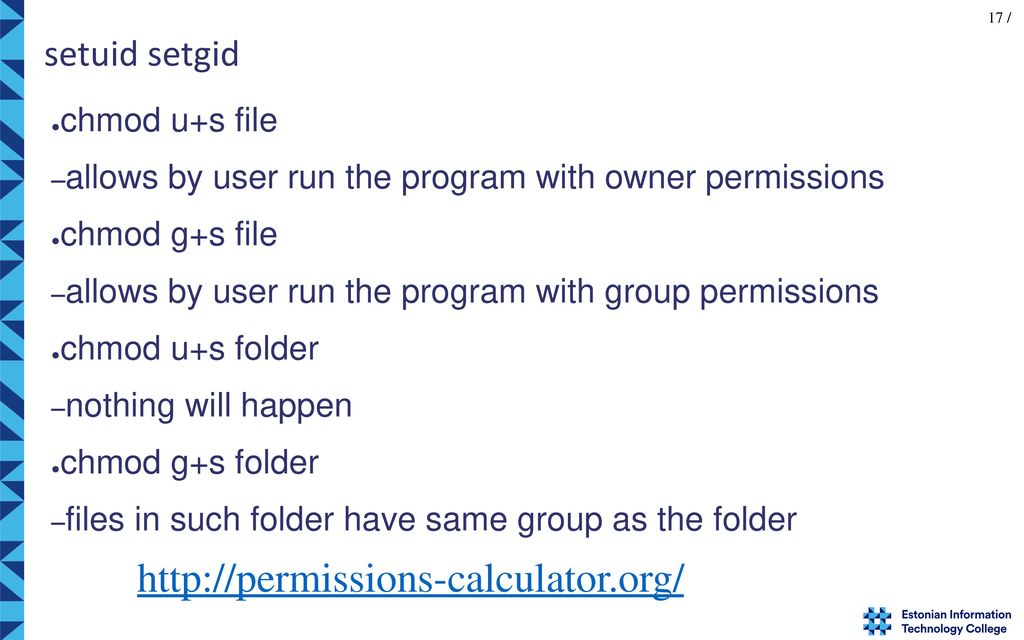
File Permissions Operating Systems I Ppt Download
/i7guGwCYcn-34e068e148ae4e918b29c86cd2d5740e.png)
Configuring Unix Linux File And Directory Access Rights
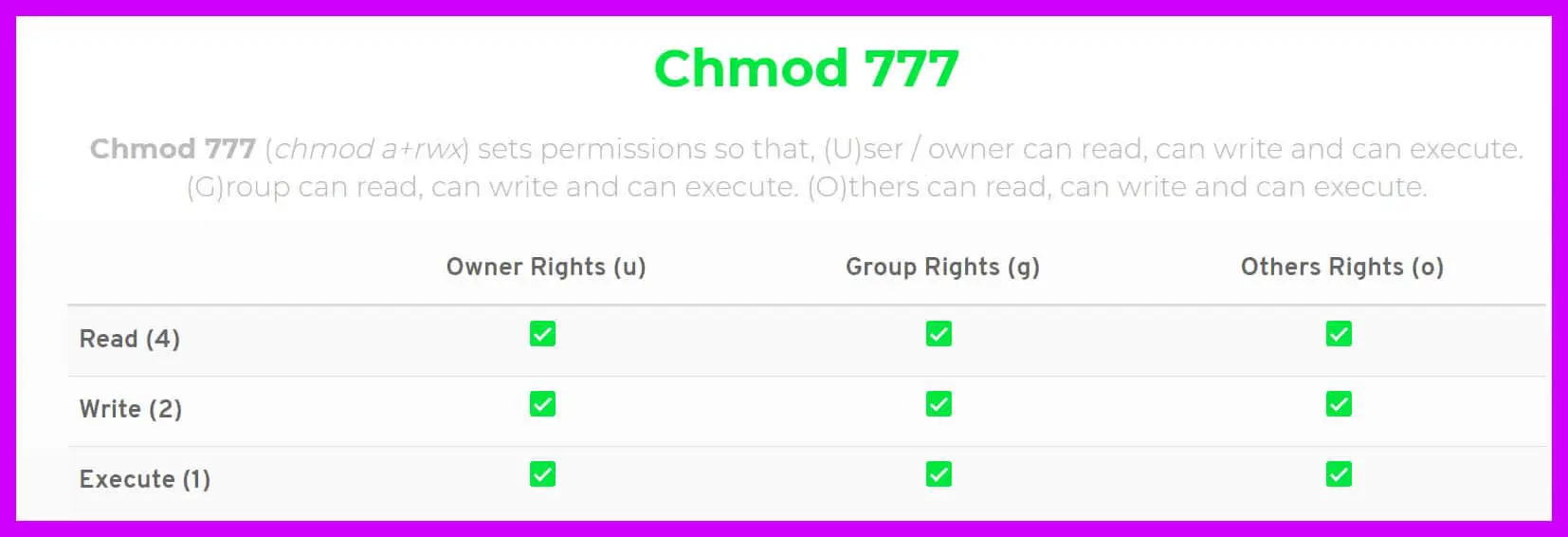
Chmod 777 A Definitive Guide To File Permissions
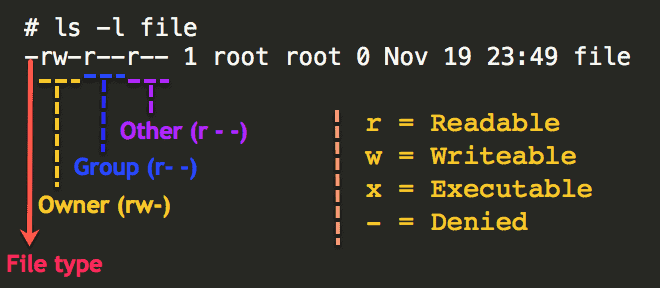
Understanding Basic File Permissions And Ownership In Linux The Geek Diary
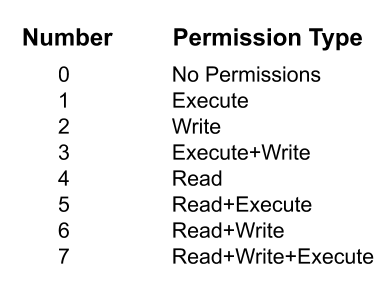
Understanding Permissions Jetapps

How To Change Directory Permissions In Linux Pluralsight

How To Use Chmod Command In Linux Explained With Examples

What Is Chmod 777

Decoded Chmod Coreutils Maizure S Projects
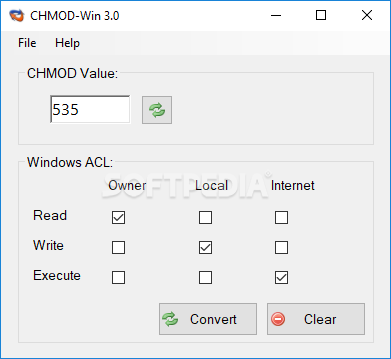
Download Chmod Win 3 0 2396

How To Use Chmod Change Mode Repair Your Pc Now

How To Use Chmod Command In Linux Explained With Examples

Linux Unix Permissions And Attributes Linuxsecrets
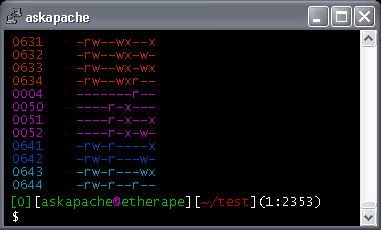
Chmod Umask Stat Fileperms And File Permissions
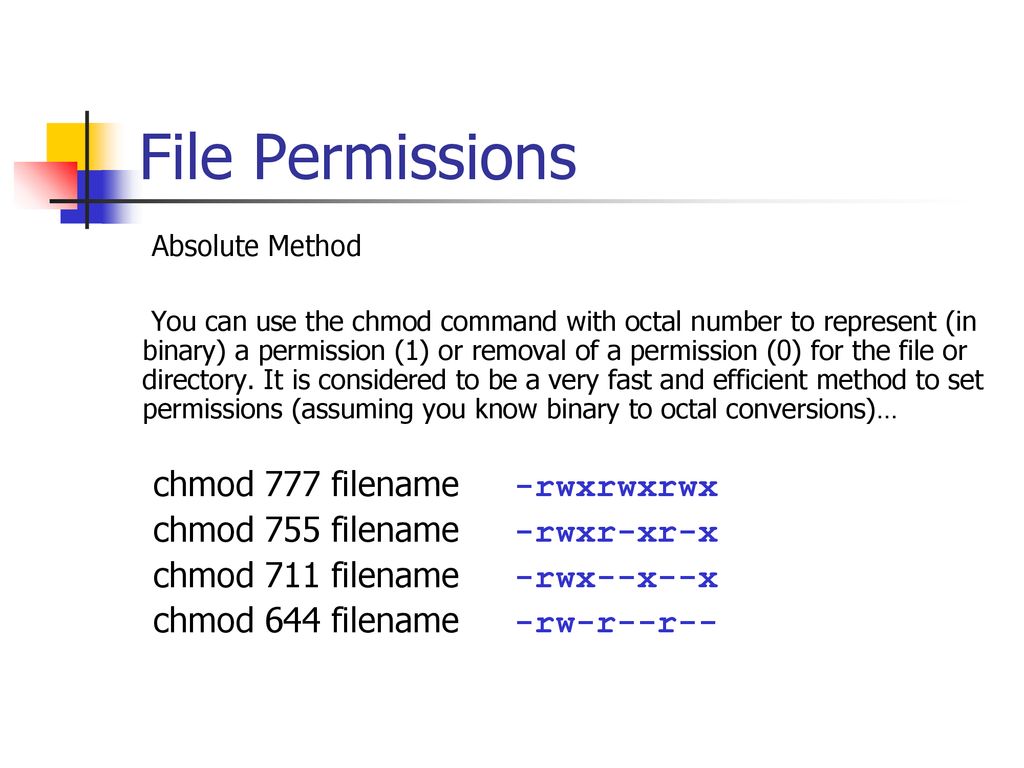
Bif703 File Permissions Ppt Download

Is There A Web Based Converter Between Rwx And The Octal Version Unix Linux Stack Exchange
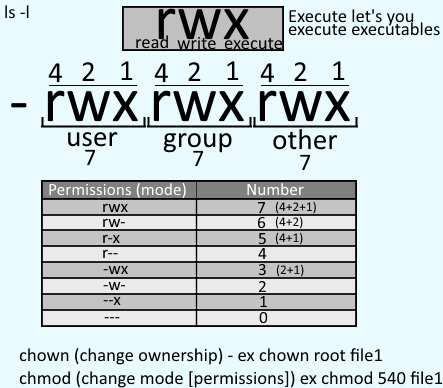
Freekb Linux Commands Chmod Change A File Or Directory Standard Permissions

Fun With Numbers In Tt Chmod Tt

How To Change Permissions Chmod Of A File Hostgator Support

9 Quick Chmod Command Examples In Linux

Ownership And Permissions
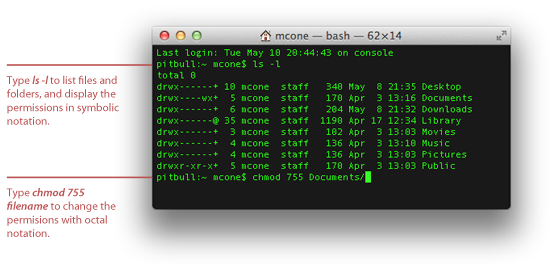
How To Set File Permissions In Mac Os X Macinstruct
Q Tbn 3aand9gcq1nsq3kxri7ryrifobs2rfobawbv4hezfw9 Ldf4feblahyn09 Usqp Cau

Chmod User Write Access

Ddg Gives You A Cheat Sheet For Any Chmod Configuration Good For Noobs Like Me Linux

Linux File Permissions Tutorial For Beginners

Pin By Dr Stefan Gruenwald On Cheatsheets Computer Science Programming Learn Javascript Linux Operating System
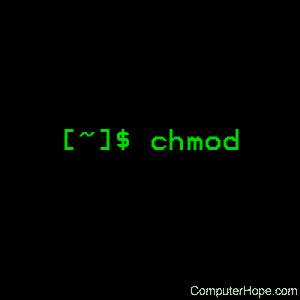
Linux Chmod Command Help And Examples

What Is Ftp Chmod Chmod Change Mode Impress Org
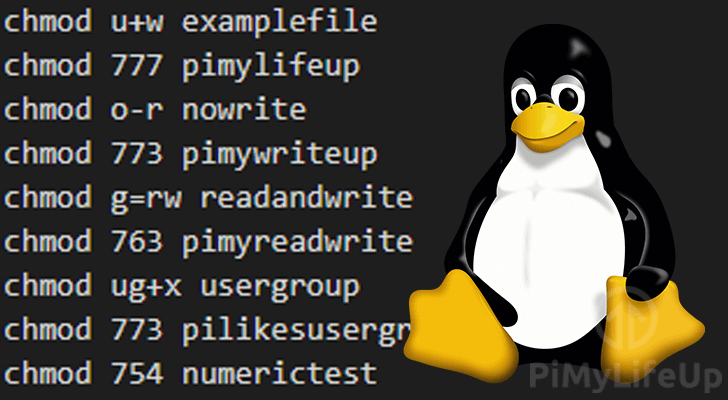
The Basics Of The Chmod Command Pi My Life Up

Command Line Understanding Chmod Symbolic Notation And Use Of Octal Ask Ubuntu

Solved Change Mode In C Chmod C Xv6 Chmod Test Program N Chegg Com

Command Line Understanding Chmod Symbolic Notation And Use Of Octal Ask Ubuntu

Modify File Permissions With Chmod Linode

Chmod X Explained Everything You Need To Know
Why Does Doing Chmod 777 Not Make A File Executable But Chmod 755 Does Isn T 777 Greater Than 755 Quora
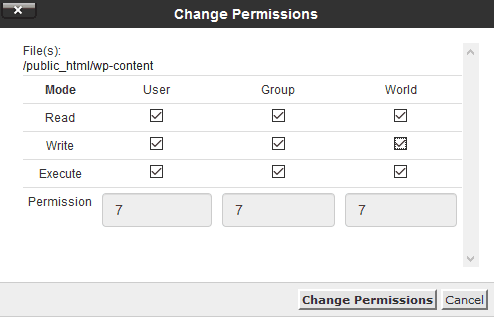
What Is Chmod 777 How To Change File Permissions For Linux Tech Ninja Pro
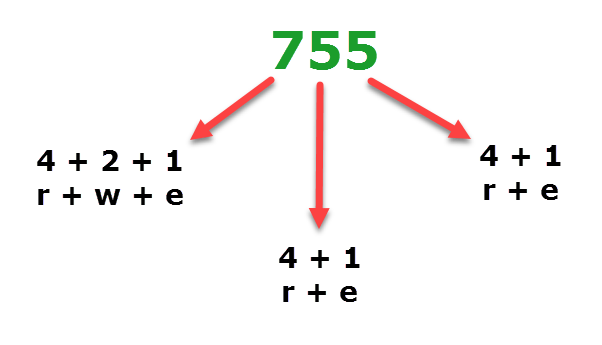
Understanding Linux Permissions And Chmod Usage

Chmod Write Access

Chmod Calculator Chmod Generator Chmod Command

Chmod 777 What Does This Mean Learn Linux Permissions Easy Way

Linux Users And Groups Linode

Chmod Ftp File Permissions Stadtaus Com

How To Use Chmod Command In Linux Explained With Examples
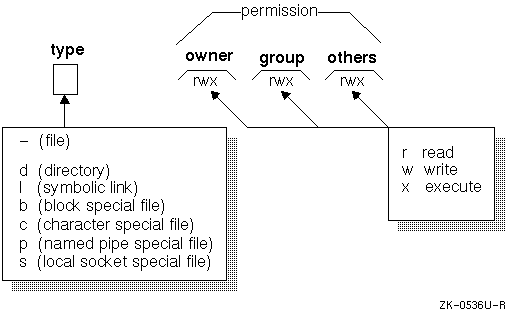
Unix Permissions

Chmod Cheat Sheet Dan Flood
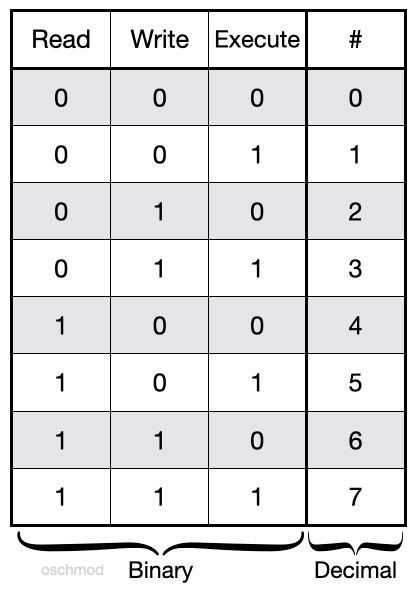
Securing Files On Windows Macos And Linux By Dirk Avery Faun Medium

Linux File Permissions Tutorial How To View And Change Permission

A Unix And Linux Permissions Primer Daniel Miessler

How To Change Directory Permissions In Linux Pluralsight

How To Use Chmod Change Mode Repair Your Pc Now

How To Use The Chmod Command On Linux
Online Chmod Calculator Free Easy To Use Converter What Is Chmod Calculator Convertforfree Wattpad

Command Line Understanding Chmod Symbolic Notation And Use Of Octal Ask Ubuntu

Chmod Command Understanding How To Grant File Permissions

Chmod Wikipedia

Ownership And Permissions

What Does Chmod 777 Mean Linuxize

Everything About Chmod Command In Linux Hackerearth

Linux Permissions Guide Plex Support

Fun With Numbers In Chmod

Csc128 Permissions And Links Chmod And Ls

Linux Linux Commonly Used Commands Authority Management Commands Programmer Sought

Chmod 777 755 655 644 And More Permissions Linux Files Tutorials

How To Use Chmod And Chown Command In Linux
Q Tbn 3aand9gcr2lfpzbutqythmvbwafnxvyggqfj7hnw6fhh Kcozkk8m5 V7o Usqp Cau

Linux Users And Groups Linode
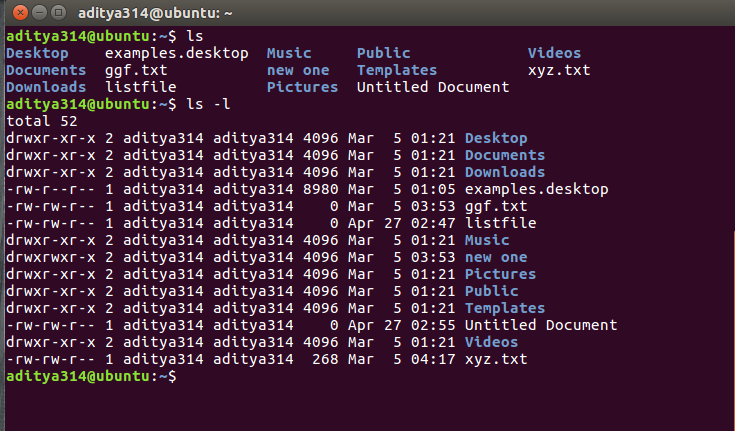
Permissions In Linux Geeksforgeeks
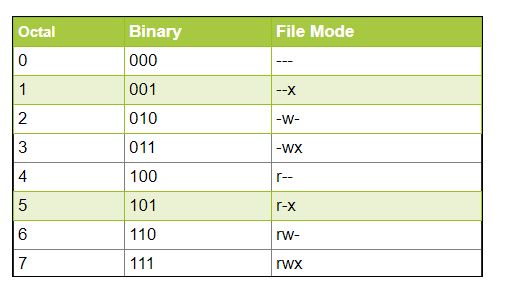
Permissions In Linux Geeksforgeeks
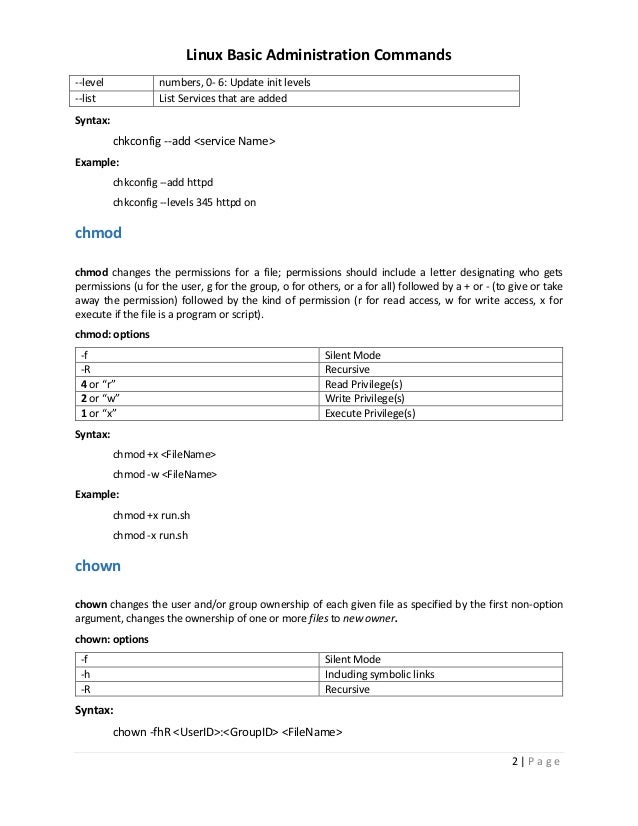
Assign Read Write Access To A User On Specific Directory In Linux

Understand Linux File Permissions Using Chmod And Chown Commands Programming Tips For Versatile Coders
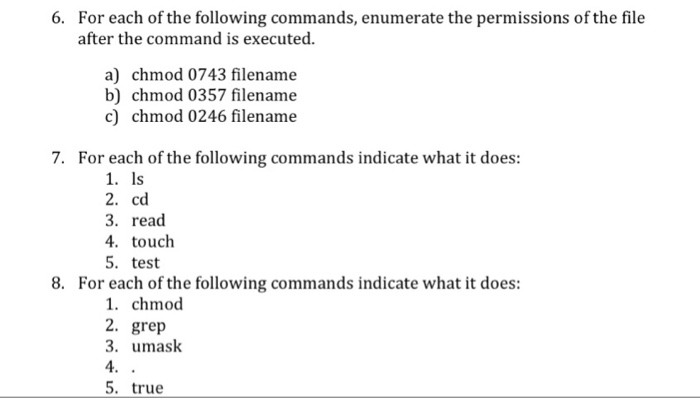
Solved 6 For Each Of The Following Commands Enumerate T Chegg Com
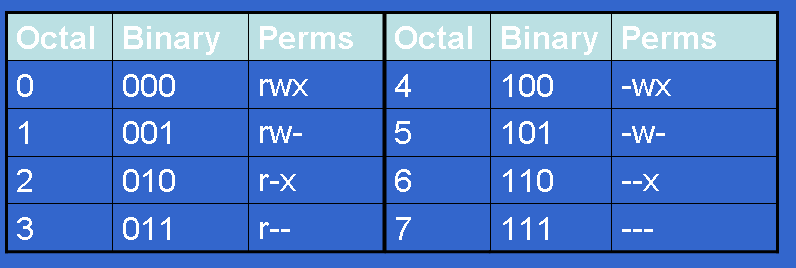
Controlling File Permissions With Umask
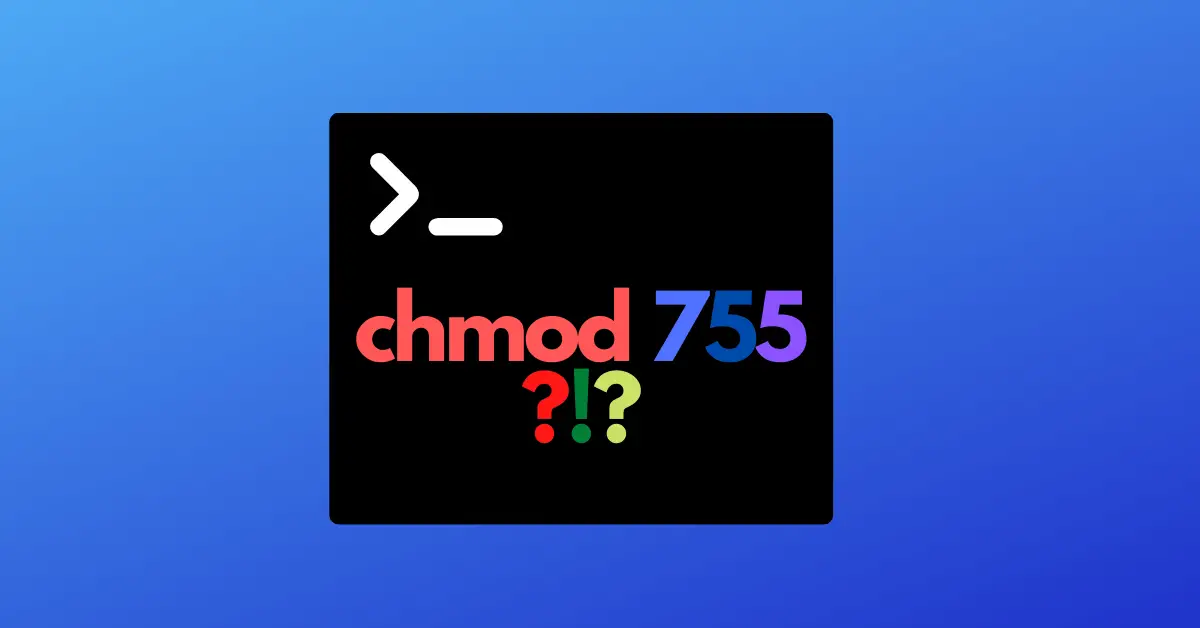
Chmod 755 Command What Does It Do Codefather

8 Linux Chmod Command Examples To Understand It The Linux Juggernaut

How To Change Directory Permissions In Linux Pluralsight
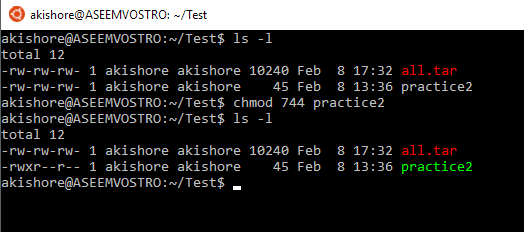
Understanding Linux Permissions And Chmod Usage
Q Tbn 3aand9gcsuqrd7yr237u Am8msiqf70j96klzxefjagdqqwjyc32uhwnrw Usqp Cau
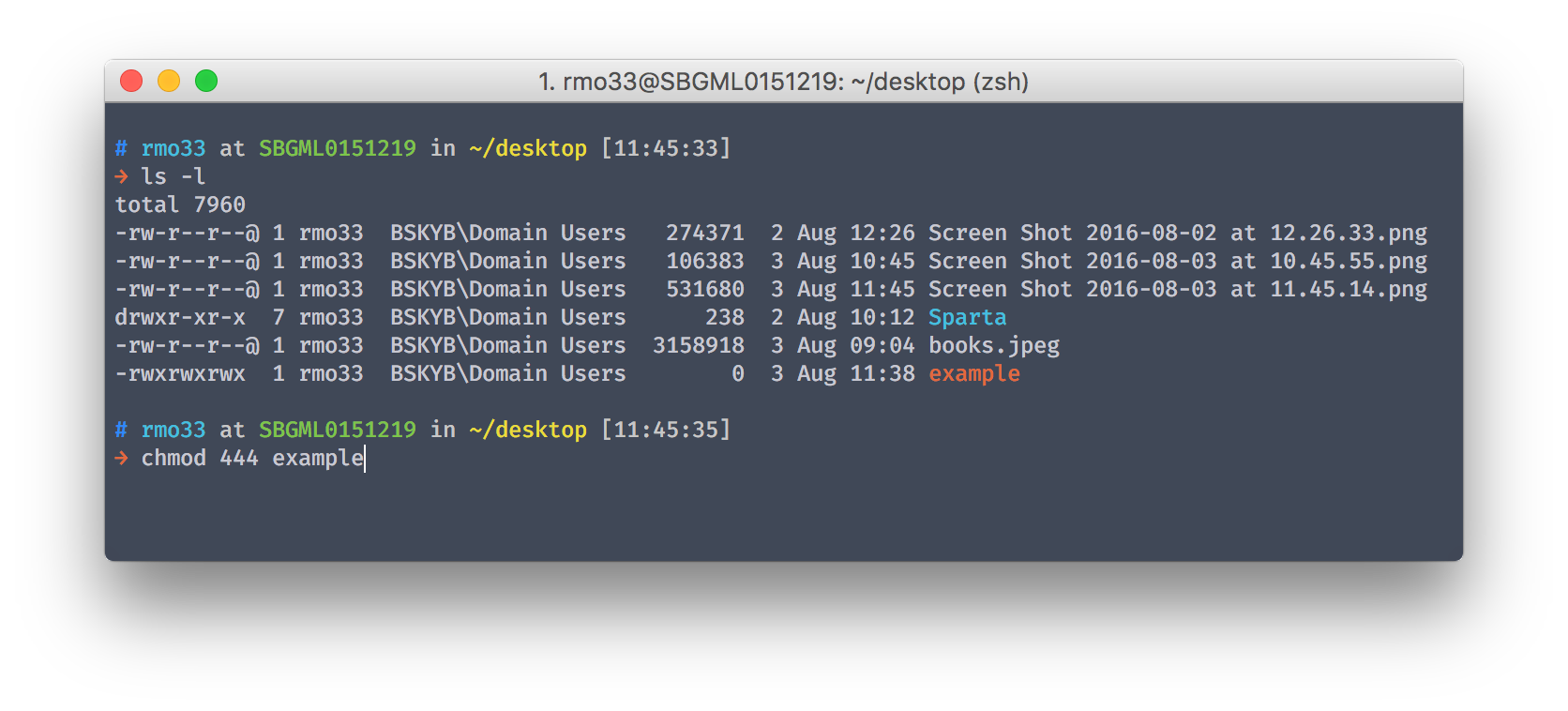
Chmod Tutorial This Is A Quick Alternative Tutorial On By Ryan Morrison Medium

Learning The Shell Lesson 9 Permissions

What Is The Difference Between Chmod And Chown Programmer Sought

Unix Command Line Basics 4 Permissions Lennoxfiles

Linux Chmod Calculator Chmodcalculator
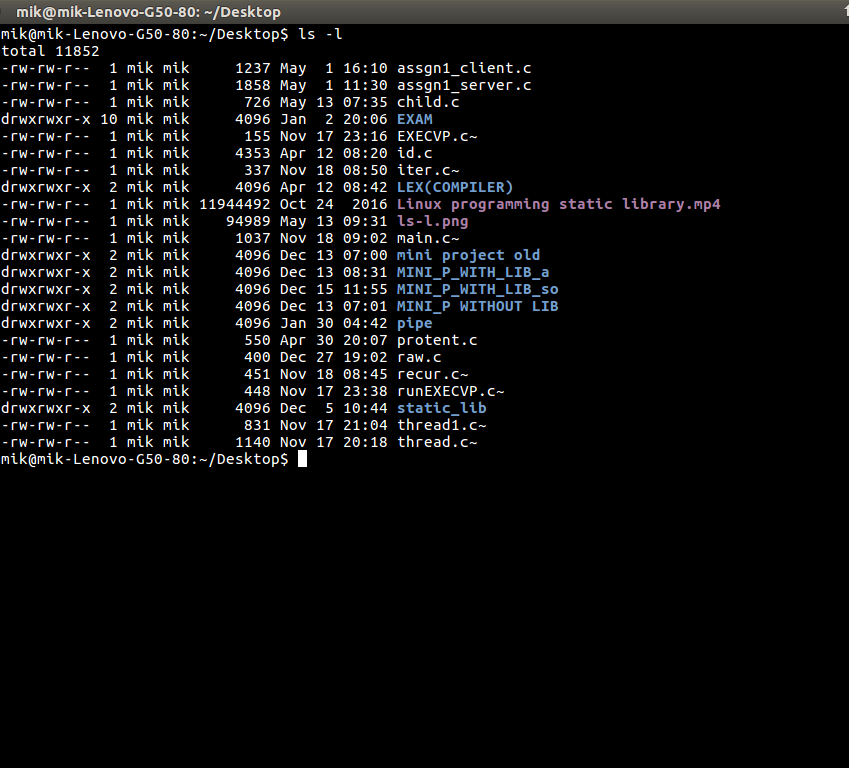
Chmod Command In Linux With Examples Geeksforgeeks
Practice Linux Permissions Basics With 7 Activities Part Ii By Nishant Sharma Pentester Academy Blog

How To Use The Chmod Command On Linux
Chmod Cheatsheet Linux
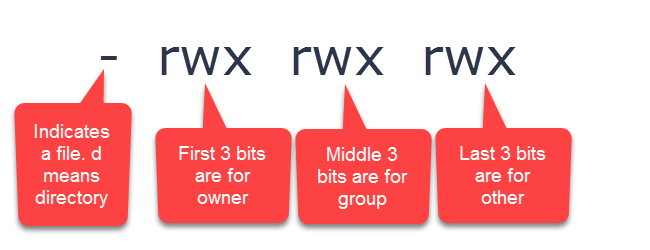
Understanding Linux Permissions And Chmod Usage
1

Extropia Tutorials Introduction To Unix For Web Technicians The Chmod Utility
Linux Chmod Tips

08 What The Chmod Numbers Mean Youtube

Understanding File Permissions

Ectzbrjpkaoq7m

Linux File Permission Javatpoint

Chmod 777 A Definitive Guide To File Permissions

What Does Chmod 775 Mean Quora
.png)
File Permissions In Linux Unix With Example

Understanding Unix Permissions And File Types Unix Linux Stack Exchange

Chmod X Explained Everything You Need To Know

Common Bash Commands



